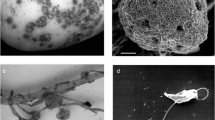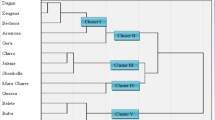Summary
The incidence of infection withSpongospora subterranea was studied in the non tuber-bearingSolanum brevidens andS. etuberosum and the tuber-bearingS. acaule, S. sucrense andS. tuberosum cvs Olympia and Pito. Shoot cuttings were grown in soil naturally infested withS. subterranea, or the roots were inoculated with a zoospore suspension. Logit models were used to analyse the data. The incidence ofS. subterranea was higher in plants inoculated with zoospore suspension than in those grown in infested soil (odds ratio (OR) 10.65). Ageing the inoculum reduced the incidence of infection in the plants (OR 0.30) without altering the interspecific differences. The ORs of infection (compared to cv. Olympia) were 0.07, 0.29, 0.60 and 2.88 forS. acaule, S. sucrense, S. brevidens andS. etuberosum. OnlyS. acaule was significantly more resistant to infection than cv. Olympia. No infection was detected in cv. Pito.
Similar content being viewed by others
References
Calvert, E.L., 1968. The reaction of potato varieties to potato mop-top virus.Records of Agricultural Research, Northern Ireland 17: 31.
Christ, B.J. & R.J. Weidner, 1988. Incidence and severity of powdery scab on potatoes in Pennsylvania.American Potato Journal 65: 583–588.
Collett, D., 1991. Modelling binary data. Chapman & Hall, Cornwall, UK, 369 pp.
Diriwächter, G. & D.G. Parberry, 1991. Infection of potato bySpongospora subterranea.Mycological Research 95: 762–764.
Fish, N., A. Karp & M.G.K. Jones, 1987. Improved isolation of dihaploidSolanum tuberosum protoplasts and the production of somatic hybrids between dihaploidS. tuberosum andS. brevidens.In Vitro Cellular and Developmental Biology 23: 575–580.
Gans, P.T., W.D. Carson & M.B. Bishop, 1987. The susceptibility of potato cultivars to powdery scab caused bySpongospora subterranea (Wallr.) Lagerh.Journal of the National Institute of Agricultural Botany 17: 337–343.
Hawkes, J.G., 1990. The potato: evolution, biodiversity and genetic resources. Smithsonian Institution Press, Washington, 259 pp.
Hughes, I.K., 1980. Powdery scab (Spongospora subterranea) of potatoes in Queensland: occurrence, cultivar susceptibility, time of infection, effect of soil pH, chemical control and temperature relations.Australian Journal of Experimental Agriculture and Animal Husbandry 20: 625–632.
Jellis, G.J., P.S. Phul & N.C. Starling, 1987. Evaluation of potato germplasm for resistance to powdery scab (Spongospora subterranea) Tests of Agrochemicals and Cultivars 8. Annals of Applied Biology 110 (Supplement).
Jones, R.A.C. & B.D. Harrison, 1969. The behaviour of potato mop-top virus in soil, and evidence for its transmission bySpongospora subterranea (Wallr.) Lagerh.Annals of Applied Biology 63: 1–17.
Jones, R.A.C. & B.D. Harrison, 1972. Ecological studies on potato mop-top virus in Scotland.Annals of Applied Biology 71: 47–57.
Karling, J.S., 1968. The Plasmodiophorales. Hafner, New York, 256 pp.
Kirkham, R.P., 1986. Screening for resistance to powdery scab disease of potatoes.Australian Journal of Experimental Agriculture and Animal Husbandry 26: 245–247.
Kormanik, D.P. & A.C. McGraw, 1983. In: Methods and principles of mycorrhizal research. Ed. N.C. Schenck). American Phytopathological Society. St. Paul. Minnesota, USA, 244 pp.
Kurppa, A., 1989. The distribution and incidence of potato mop-top virus in Finland as determined in 1987 and on the variation of disease symptoms in infected potatoes.Annales Agriculturea Fenniae 28: 285–295.
Merz, U., 1989. Infectivity, inoculum density and germination ofSpongospora subterranea resting spores: a solution-culture system.EPPO Bulletin 19: 585–592.
Plaisted, R.L. & R.W. Hoopes, 1989. The past record and future prospects for the use of exotic potato germplasm.American Potato Journal 66: 603–627.
Ross, H., 1986. Potato breeding-problems and perspectives.Journal of Plant Breeding Supplement no. 13. Paul Parey, Berlin, 132 pp.
Ryden, K., B. Erikson & V. Insunza, 1986. Rostringar hos potatis orsakade av potatismopptoppvirus (PMTV). (Spraing in potato tubers caused by potato mop-top virus).Växtskyddsnotiser 50: 97–102.
Wastie, R.L., P.D.S. Caligari & S.J. Wale, 1988. Assessing the resistance of potatoes to powdery scab (Spongospora subterranea (Wallr.) Lagerh.).Potato Research 31: 167–171.
Author information
Authors and Affiliations
Rights and permissions
About this article
Cite this article
Mäkäräinen, E., Rita, H., Teperi, E. et al. Resistance toSpongospora subterranea in tuber-bearing and non tuber-bearingSolanum spp.. Potato Res 37, 123–127 (1994). https://doi.org/10.1007/BF02358712
Accepted:
Issue Date:
DOI: https://doi.org/10.1007/BF02358712




